Amazon Kindle Fire Review
by Anand Lal Shimpi & Vivek Gowri on November 29, 2011 3:31 AM EST- Posted in
- Tablets
- Mobile
- Amazon
- Kindle Fire
- Kindle
Mario Twins
Rumor had it that in order to save time (and likely cost) in bringing the Fire to market, Amazon had opted to use the same design as the BlackBerry PlayBook courtesy of the ODM that made both: Quanta.
ODMs like Quanta will build anything you want or they'll do slight modifications to an existing design to suit your needs. The idea is you don't need to be an expert at everything. If your differentiation is primarily software and you just need a fast hardware platform, Quanta (or Pegasus or Foxconn, etc...) will give you that and let you roll your own software stack on top of it. It's not all that uncommon in the industry. This is actually how companies like Marvell work in the SSD space as well. They'll give you the hardware, but the most successful drive makers simply use the Marvell hardware as a base platform - they all write their own firmware.
Aesthetically, the Kindle Fire looks a lot like the PlayBook. The dimensions, screen size/resolution and even build quality are eerily reminiscent of one another although the PlayBook is tangibly larger. Both tablets have a large screen bezel (the PB's is bigger) and soft touch plastic on the back. The power/lock button on the Kindle Fire is also quite similar to what's used on the PlayBook. It's in a different location and is much easier to actuate but it's clear that even the buttons came from a similar parts bin.
A look inside both devices shows a different arrangement of components and a different layout on each motherboard. Our own Brian Klug spotted a curious reference on each board however: the PlayBook's board is labeled Rev. G while the Fire's board is labeled Rev. F. Is it possible that the two boards are simply different revisions of one another?
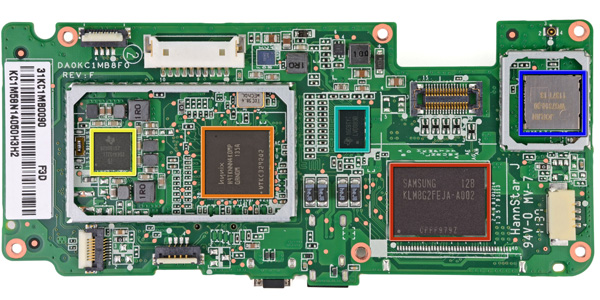
Image Courtesy iFixit - Kindle Fire Motherboard
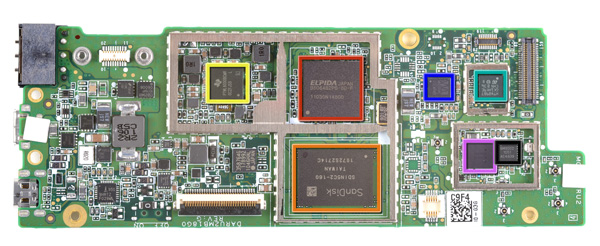
Image Courtesy iFixit - Kindle Fire Motherboard
Either way it's clear Amazon departed from its usual unique design approach with the Kindle Fire. While previous Kindles were fairly recognizable among a sea of devices, the Kindle Fire looks and feels like a PlayBook. In fact, when it's off and sitting on your desk, you'd be hard pressed to tell that it was something made by Amazon. The large 'kindle' lettering on the back was likely designed to address this brand identity issue, but it really was the only thing Amazon could have done given the generic looking platform.
Looks aren't a major concern of mine but I do wonder what we can conclude from this. Either the Kindle Fire was a rushed project to catch the 2011 holiday shopping season or it's a sign that value tablets can't look very special, or perhaps both?
Simplicity in Hardware
Despite the physical similarities to the PlayBook, Amazon whittled down the number of buttons on the Kindle Fire to just one: power/lock. Volume controls are entirely in software, and to be honest I don't miss the physical buttons. As this isn't a smartphone, I don't need to worry about quickly silencing a ring or increasing the volume of a call. The tradeoff here makes sense.
As I mentioned before, the round power/lock button is easy to actuate. The bigger problem is the button's location: at the bottom of the Kindle Fire. On the bright side it does keep the button out of your way when you're reading, it just happens to be in the exact opposite location of where years of using modern smartphones/tablets have taught us to expect it. Then again, an oddly placed power/lock button isn't too big of a deal when you've got a configurable software screen lock.
A 1/8-inch headphone jack and micro USB port keep the power/lock button company. Amazon doesn't ship the fire with a micro USB cable, instead you just get a power brick with a micro USB end for charging the Fire. To Amazon's credit, to use the Fire as a Kindle you never need to hook it up to your Mac or PC. A standard USB cable is only really needed for getting your own music, videos or apps onto the device.
There are a pair of stereo speakers on the opposite end of the device. The volume control feels non-linear and the speakers get loud enough to make their position a bit awkward. Hearing loud noises from one side of the device and not the other isn't really desirable, particularly since you'll likely be watching movies on the Kindle Fire in landscape mode.


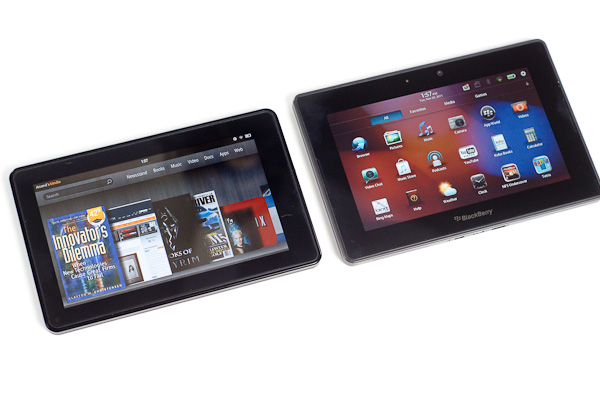
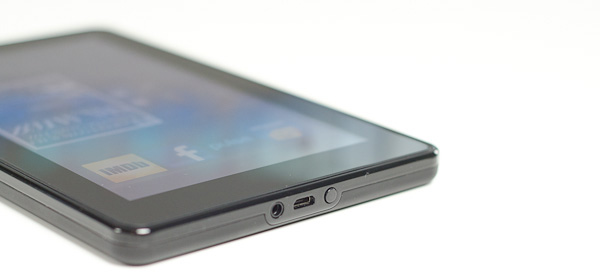
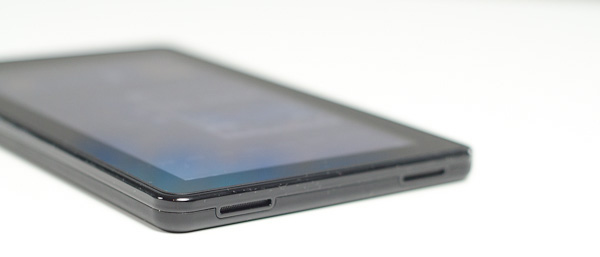








70 Comments
View All Comments
Fincanejoe - Tuesday, November 29, 2011 - link
I will try to correct you but you are so turned around a far off the path that this may be difficult.I own a Kindle 2 as well as a Kindle Fire and have owned a ipad and android tablet:
* No one who owns a Kindle (non Fire) would ever suggest Kindle Fire, ipad, or Android tablet could ever replace the passive - not light emitting - Kindle as a reader. Anyone who has stared at a computer screen for too long and/or Kindle owners understand this.
* Kindle Fire is not trying to accomplish all the tasks the ipad or android tablets are trying to accomplish. That's just it "trying to accomplish".
The ipad and droid tablets are tweeners trying to accomplish what laptops do well and cell phones do well all in one device. The problem is none of the tablets does the job very well at his point and. They are "cool" devices but one the cool wears off and reality sets in you realize a tablet is not as good as a laptop (for what laptops do) and not good enough as a cell (for what cells do) to replace either. That's why I returned my ipad and adroid tablet after the cool factor wore off (couple of days).
The Kindle Fire does not try to bite off such a large chunk of the pie. It fills a smaller niche and does it well. I use my google account (mail,docs,etc) and Amazon account for storing content. What the Kindle fire does is manage and connect me to all this content exceptionally well with a better screen, much longer battery life, smaller footprint. ipad is too big, this device is just the right size for this purpose. And yes if I want to read a book in a pinch amazon sync bookmarks where I left off on my real reader, Kindle 2.
Lets not for get this small item either - K Fire sets you back $200 while the ipad sets you back at least $600 until the next great device comes around in about 6 - 12 months.
This is how Kindle Fire is an Apple ipad market share "stealer" not killer. Sure there will be the Apple fanboys but aside from that, the practical people will stick to their laptops, cell phones, and Kindles.
solipsism - Tuesday, November 29, 2011 - link
Lots of hate for tablets. You might want to rethink that for a more objective position.Sabresiberian - Wednesday, November 30, 2011 - link
Ummm - well, if he hates tablets, I say he has a right to, since he has actually bought them and used them. He at least had an open enough mind to try them out before he decided that they don't work very well.;)
joshv - Wednesday, November 30, 2011 - link
"No one who owns a Kindle (non Fire) would ever suggest Kindle Fire, ipad, or Android tablet could ever replace the passive - not light emitting - Kindle as a reader. Anyone who has stared at a computer screen for too long and/or Kindle owners understand this."Incorrect. I love the passive Kindle display, but I also read a lot in bed, and I hate the hack of an external LED (clipon or otherwise). The Fire works great in bed, and I suffer no eyestrain whatsoever. It's pixel density is also quite high, so text looks smooth and clear.
I've really never understood the LED eyestrain thing. It just seems like a self-perpetuating meme. People hear it, and when their eyes hurt they go "yeah, must be because I stare at an LED screen all day long".
wicko - Wednesday, November 30, 2011 - link
Yeah, I seriously doubt it's the LCD screen that's causing eye-strain or headaches. I look at LCDs 10-12 hours a day, as do many others, and I don't have any problems like that. Sure, there are some more sensitive to light then others (I have brown eyes, which are the least susceptible to problems like that), but it isn't a general thing that happens to everyone, and I see no proof that it's the LCD itself. I start getting headaches when I play Battlefield 3 for too long, and I imagine it's because I'm getting blasted with colour, fast moving objects, and, probably the main cause, sounds of explosions and weapon fire. But I don't have these problems when I'm programming/browsing/etc.wicko - Wednesday, November 30, 2011 - link
Also forgot to mention, when I'm playing BF3 and I get those headaches, it's because I've been playing for 4-5 hours straight. If I took breaks in between, I wouldn't need to take tylenol :pReflex - Wednesday, November 30, 2011 - link
You just said you have no problems with LCD's, but then you listed your problems with LCD's.I think you've missed the point. On eInk there is no need for a break after an hour or two. The screen does not fatigue the eyes. Even if it were in full motion, 3D with color as rich as a LCD, it would not fatigue the eyes to watch.
joshv - Thursday, December 1, 2011 - link
I can read my Fire and stare and LCD monitors all darned day long. No headaches, no eyestrain.Finraziel - Thursday, December 1, 2011 - link
Nope, with e-ink I get a neckstrain because I lie in uncomfortable positions keeping the damn thing within the light... I was actually going to post because I was surprised at Anand/Vivek so boldly stating that e-ink is better than LCD for reading, it's not that simple and just because a lot of people prefer e-ink does not change the fact that it's a matter of preference.I myself gave my e-ink device (not a kindle but a sony pocket edition, unfortunately I'm on the wrong side of the atlantic, can't get a fire either...) to my mom because I found that I actually preferred reading on my phone(!) to using the e-ink device, exactly because I usually read in dim/dark conditions and as good as never in direct sunlight.
genomecop - Thursday, December 1, 2011 - link
Couldn't agree more.